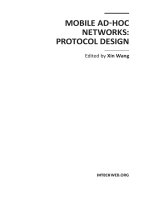Mobil Ad Hoc Networks Protocol Design Part 3 pdf
Bạn đang xem bản rút gọn của tài liệu. Xem và tải ngay bản đầy đủ của tài liệu tại đây (1.44 MB, 40 trang )
Mobile Ad-Hoc Networks: Protocol Design
72
The basic idea is twofold: (i) We consider the intra-flow contention problem with an analysis
model that account for the contenting links’ behavior, instead of just calculating the
contention count. (ii) The model envelops important factors for intra-flow contention, i.e.,
neighboring interference, hidden-node collision and possible multi-rate scenario, which
make it approach reality and obtain accurate results. (The results obtained by our proposed
model under the aforementioned scenario are also shown in Fig. 6, with the legend of Model-
based AB estimation.)
0 2 4 6 8 10 12 14 16 18
200000
400000
600000
800000
1000000
1200000
1400000
1600000
1800000
Average collision probability
End-to-end AB, bps
hop account (n)
Average-based AB estimation
Dviation-based AB estimation
Model-based AB estimation
Real AB (Simulation results)
0.00
0.05
0.10
0.15
0.20
Hidden-node collision probability
Fig. 6. End-to-end AB while varying the hop count
4. Model-based approaches for AB prediction
The model-based approaches are of redictive power and the current challenge is to derive
more accurate and scalable analysis model. We will show our effort on this topic in this
section.
4.1 Analytical model
For a better understanding, we give an overview of our model as shown in Fig. 7. Our
model takes network information (topology and existing traffic), radio-dependent
parameters and incoming traffic throughput demands as input and outputs the predictive
throughputs of both the incoming flow and existing flows. Such a model is a powerful tool
for performing what-if analysis and facilitating network optimization and diagnosis.
Although in this chapter we focus on the throughput demands, or bandwidth requirement,
of the flow, there is coupling of bandwidth and delay over a wireless link as shown in
(Chen, Xue et al., 2004). So the model in this chapter can potentially be extended to analyze
other QoS requirements, such as delay, by relating them to the network parameters,
however this is out the scope of this chapter.
Available Bandwidth Estimation and Prediction in Ad hoc Networks
73
Fig. 7. Model structure
The model consists of three major components: S-R (i.e., sender-receiver) pair model,
interference model and bandwidth requirement mapping model. These models will be
covered in Sections 3.2, 3.3 and 3.4 respectively. The S-R pair model gives the link state from
the view of an S-R pair, and considers important probabilities such as the transmission
probability, the unsuccessful transmission probability, the sense busy probability and the
non-empty transmission buffer probability. The interference model constructs the
contention graph of the network, in order to analyze the interference of contending links.
The bandwidth requirement mapping model relates the network parameters in the S-R pair
model and interference model to the bandwidth requirement of the incoming flow(s). It is
also important to initiate some key parameters that used in this model, which is explained in
Section 3.5.
4.1.1 S-R pair model
The behavior of an S-R pair that employs an 802.11 protocol is dictated by the occupation of
the ‘air’ around it (the channel). We denote the sender and receiver respectively as N
k-1
and
N
k
, and the link between them as Link k.
We adopt the concept of generic slot used in (Dao & Malaney, 2008) (which is also denoted
as variable length slots (VLS) in (Li, Qiu et al., 2008)), thus for the channel sensed by the
Link k, 4 different states can be identified:
i. Idle—N
k-1
has seen the medium as idle and, either it has no data to send or its backoff
counter has not reached 0 (i.e. backoff is in process).
ii. Successful transmission—N
k-1
has transmitted a packet, received an ACK from N
k
and
is about to resume backoff.
iii. Unsuccessful transmission—N
k-1
has transmitted, timed-out while waiting for an ACK
from N
k
and is about to resume its backoff.
iv. Sense busy—N
k-1
has detected the medium busy due to one or more other nodes
transmitting, by means of either physical or virtual carrier sensing (i.e., the Network
Allocation Vector, NAV), and has suspended its backoff until the NAV and DIFS/EIFS
indicate that the backoff can resume.
The average time intervals during which Link k remains in idle, successful transmission,
unsuccessful transmission and sense busy are denoted by σ, T
k
, C
k
, and B
k
, respectively. σ is
constant, equal to the backoff slot. The duration of the other intervals can be variable,
depending on the access mechanism, the frame size, and the sending rate. From the
perspective of the S-R pair, the evolution of the channel state of Link k can be abstractly
represented by a temporal diagram such as the one exemplified in Fig. 8(b).
So the average length of the Generic slot of link k can be expressed as:
τ
τττσ
=+−+− +−−(1 ) (1 ) (1 )(1 )
kkkkk kk kkk k k
EpC pT bB b
(10)
Mobile Ad-Hoc Networks: Protocol Design
74
Nk-1
Link k
Nk
T
k
C
k
B
k
σ σ σ σ σ σσ σ t
(a) The S-R pair; (b) The state of the channel between the S-R pair
Fig. 8. S-R pair model
where
τ
k
represents the transmission probability on one time slot;
k
p
is the unsuccessful
transmission probability.
k
b is the channel busy probability. Then the normalized channel
utilization ratio (i.e., the normalized transmitting airtime whether successfully or not,
represented by
k
x ) and the successful transmission time ratio (represented by
k
y ) of Link k
can be expressed as:
ττ
+−
=
(1 )
kk k k k k
k
k
p
CpT
x
E
(11)
τ
−
=
(1 )
kkk
k
k
p
T
y
E
(12)
The throughput of Link k is, in pkt/s
τ
−Λ
=
(1 )
kk
k
k
p
S
E
(13)
where
Λ
is the effective load fraction.
In equation (10), the average durations of a successful transmission and of an unsuccessful
one are known a priori according to the 802.11 DCF standard (see (Bianchi, 2000), here we
neglect the propagation delay). They are as follows under the Basic mode and RTS/CTS
mode:
()
()
Basic
k
Basic
ktimeout
T DIFS DATA SIFS ACK
CDIFSDATAACK
⎧
=+ ++
⎪
⎨
=+ +
⎪
⎩
(14)
⎧
=+++ ++⋅
⎪
⎨
=++
⎪
⎩
(/)
(/)
3
RTS CTS
k
RTS CTS
ktimeout
TDIFSRTSCTSDATAACKSIFS
CDIFSRTSCTS
(15)
In single-hop 802.11 networks all nodes are synchronized and the duration of a busy period
equals the sum of the other nodes’ transmitting duration. However, in the multi-hop case,
transmissions of different nodes can overlap randomly due to the lack of coordination,
which makes the determination of one node’s busy period more complex. We take the
assumption that if two links, for instance Link i and Link j, cannot sense each other, their
action is independent to each other, this assumption is shown reasonable in (Gao, Chiu et
al., 2006). So the overlap probability, denoted by P
overlap
(i,j), of these two links’ transmitting
airtime can be approximated as
∈
×
=
−
∑
(, )
(, )
1
ij
overlap
c
cvij
xx
Pij
x
(16)
Available Bandwidth Estimation and Prediction in Ad hoc Networks
75
where v(i) represents the set of contending links (i.e., the links that contend with each other,
and we will present them in Section 3.3) of Link i and v(i,j) the set of common contending
links of Link i and Link j. In Eq. (16), the numerator is the normalized probability that they
transmit at the same time. When their common contending links are transmitting, neither of
them can transmit, therefore the denominator represents the total time that they can use to
transmit. Eq. (16) is referred to as the second-order approximation, which will be used again in
our future analysis. Thus the sense busy time of Link k can be obtained via
∈∈
∉
∈
⎛⎞
⎜⎟
=−
⎜⎟
−
⎜⎟
⎝⎠
∑∑
∑
∪
12
12
122
12
() , ();
()
(,)
1
ii
ki k
ivk ii vk
c
ivi i
cvi i
xx
Bx E
x
(17)
A. Calculating the transmission probability τ
We should keep in mind that to support an application throughput along one route, the
nodes on this route may have different transmission probabilities considering they may
experience different collision probabilities. But in this section we temporarily drop the
subscript, k, of the symbols for brevity.
A node can begin transmission when the following three conditions are satisfied: i) the node
has data to transmit; ii) the link is idle; and iii) its random backoff counter reaches 0. The
first one is related to the transmission queue. The last two are related to the interference by
neighboring nodes. More specifically, one node’s backoff counter is related to the
unsuccessful transmission probability it experiences.
The transmission probability τ is a function of unsuccessful transmission probability p,
which is first given in (Bianchi, 2000) under saturated situations. Recently, in (Kumar,
Altman et al., 2007)and (Malone, Duffy et al., 2007) similar expressions of τ as a function of p
are derived respectively for a large class of backoff mechanisms and for unsaturated
situations. The complete expression of τ for 802.11 that takes into account the maximum
retransmission limit jointly with the maximum window size and non-saturation case is
given by
τη
⎛⎞
−
=⋅ −
⎜⎟
−−−− −
⎝⎠
0
22
0
(1 )
(1 )(1 )(1 (1 ) ) 1
W
qW q p
qp q q
(18)
where
η
is the stationary probability of a node being in the state where the backoff process
is complete, but the node’s transmission queue is empty (Malone, Duffy et al., 2007).
η
−
++−−−
=−+ +
−−− −
⎛⎞⎛ ⎞
−−
+ − − +
⎜⎟⎜ ⎟
−− −− −
⎝⎠⎝ ⎠
0
0
2 2
00 0
2 1
2
0
0
(1) (1)((1)(1))
1
(1 )
2(1 )(1 (1 ) ) 2(1 )
2(1 (2))
(1 ) 1
2(1 )(1 ) 1 (1 ) (1 2 )
W
m
W
qW W qW p q q p
q
qq q
pq W p p p
W
p
qp q p
(19)
And q is the probability that there is at least one packet in the queue after a transmission,
which is mainly related to the traffic load and it will be discussed in Subsection D. W
0
and
2
m
W
0
are respectively the node’s minimum and maximum contention window.
Mobile Ad-Hoc Networks: Protocol Design
76
B. Calculating the unsuccessful transmission probability p
The unsuccessful transmission probability p may arise from collisions or channel failure. We
identify three different categories of unsuccessful transmissions as follows: (i) due to
collision between synchronized nodes, which occurs with the probability of l
sc
; (ii) due to
hidden nodes, which occurs with the probability of l
hc
; (iii) due to channel errors, which
occurs with the probability of l
e
. And we assume that these three probabilities are
statistically independent, then a transmission is successful if it does not suffer from any of
the three types of unsuccessful transmission mentioned above (they may occur
simultaneously) and thus the unsuccessful transmission probability is:
=
−− − −1(1 )(1 )(1 )
sc hc e
p
lll
(20)
Collisions between synchronized nodes are the traditional type of packet losses due to the
MAC protocol considered in single-hop 802.11 networks (Bianchi, 2000). Indeed, when all
senders are in range of each other, the DCF function is able to synchronize all nodes in such
a way that all transmission attempts happen at well defined slot boundaries recognized by
all nodes. As a result, in this network scenario the conditional unsuccessful transmission
probability for Link k is simply given by
τ
≠∈
=− −
∏
,()
1(1)
k
sc i
ikivk
p
(21)
If each node has the same transmission probability then we will obtain the same result as in
(Bianchi, 2000):
τ
−
−−
1
1(1 )
n
, where n is the total number of nodes in the WLAN. However,
in a multi-hop topology the DCF function fails to synchronize all nodes and the hidden node
collision usually account for an important component of the overall packet collision
probability. The hidden node collision has been modeled in (Zhao, Wang et al., 2010). If
node j is node k’s hidden node, the collision probability experienced at node k due to node j
is as follows (using
,,(1)kj
hc
p and
,,(2)kj
hc
p to respectively denote the case when node j is the Type
I and Type II hidden node
2
to node k)
∈∈
∉
∈
=
×
−+
−
∑∑
∑
∪
,,(1)
(,) , (,);
()
(,)
1
1
j
kj
hc
mn
c
cvjk mnvjk
c
mvn n
cvmn
x
p
xx
x
x
(22)
∈∈
∉
∈
+
=
×
−+
−
∑∑
∑
∪
,,(2)
(,) , (,);
()
(,)
1
1
kj
kj
hc
mn
c
cvjk mnvjk
c
mvn n
cvmn
xx
p
xx
x
x
(23)
Once we know the type of hidden node to Link
i, the overall hidden node collision
probability is the union of
∈
,
,()
kj
hc
pj
hk ( ()hk represents the set of hidden node to Link k),
namely:
2
Please refer to (Zhao, Wang et al., 2010) for further detail.
Available Bandwidth Estimation and Prediction in Ad hoc Networks
77
∈∈
∉
∈
×
=−
−
∑∑
∑
∪
,,
,
() , ();
()
(,)
1
km kn
kj
k
hc hc
hc hc
jhk mnhk
c
mvn n
cvmn
pp
pp
x
(24)
Here, we also use the second-order approximation to unfold the union expression.
Note that the collision may not necessarily result in packet loss, considering the capture effect.
The capture effect is the ability of certain radios to correctly receive a strong signal from one
transmitter despite significant interference from other transmitters. It means that even when
two nodes simultaneously transmit, the one with stronger power still has chance to be
correctly received. We introduce a parameter
α
≤
≤0 1 to reflect the average impact of the
capture effect, which is referred to as the capture indicator in this chapter, thus
α
=
−(1 )
sc sc
lp (25)
α
=
−(1 )
hc hc
lp (26)
To obtain p, the problem is reduced to obtaining the channel error probability l
e
and the
capture indicator α. We show how to obtain them via measurement in Section 4.1.4.
C. Calculating the sense busy probability b
The sense busy probability, b, is the probability that the channel becomes busy after an idle
slot due to the activity of other nodes, under the condition that link k does not start its own
transmission. It is equal to the probability that at least one contending link is transmitting,
whether it is successful or not
τ
∈
=
−−
∏
∪()
1(1)
ki
ivk k
b (27)
D. Calculating the non-empty transmission buffer probability q
The variable q represents the probability that there is at least one packet in the queue after a
transmission. In the previous models, to analyze the performance of saturated wireless
networks, each node in the network is assumed to always have a packet to transmit (i.e.,
q=1). But according to the work in (Zhai, Chen et al., 2006), the network does not perform
best when it is saturated and extensive research has been undertaken to prevent the network
from saturation. So the effect of q must be considered in the model.
We introduce a parameter λ representing the rate at which packets arrive at the node buffer
from the upper layers, and measured in pkt/s. The mean time between two packet arrivals is
defined as the mean inter-packet time, and thus its value can be calculated as
λ
1/ .
A crude approximation in the unsaturated setting is to assume that packet arrivals are
uniformly distributed across slots and set
{}
λ
⎧⎫
⎪⎪
==⋅
⎨⎬
⎪⎪
⎩⎭
min , 1 min , 1
-
E
qE
mean inter packet time
(28)
where E is the average length of the Generic slot obtained via Eq. (1) and measured in
seconds.
If the traffic arrives in a Poisson distribution, then probability q can be well approximated in
a situation with small buffer size through the following relations as (Malone, Duffy et al.,
2007) and (Daneshgaran, Laddomada et al., 2008) revealed:
Mobile Ad-Hoc Networks: Protocol Design
78
λ
−
=−1
E
q
e (29)
Here the packet arrival probability is assumed independent to the channel state. A more
accurate model can be derived upon considering different values of q for each backoff state.
However, it has been proved in (Malone, Duffy et al., 2007) that as state-dependent models
are more computational involved, there seems little advantage in employing a state-
dependent model instead of the state-independent model. Thus it is a reasonable solution
using a mean probability valid for the whole Markov model.
Note that, in (29), placing the node in saturation by taking the limit q->1, the model is
reduced to a model for saturated scenarios.
4.1.2 Interference model
Given a set of wireless nodes, a network can be mapped into a contention graph (Chen, Low
et al., 2005). This contention graph is used to represent interference (i.e. which link is
interfering with which link) which has a consequent impact upon throughp4ut. We use
contention graphs to model the interference between contending links. In the literature,
contention graph models have not considered contention due to hidden nodes which is an
important difference in our work.
The process of mapping a network topology into a contention graph is introduced in (Chen,
Low et al., 2005) and (Gao, Chiu et al., 2006). To illustrate this concept, we take the 4-hop
chain network in Fig. 9(a) as a simple example, where nodes on the route are placed with the
transmission distance
R
tx
. And R
CS
represents the carrier-sense range.
0
N
1
N
2
N
3
N
4
N
Link 1
Link 2
Link 3
Link 4
CS
R
0
N
1
N
2
N
3
N
4
N
1
2
3
4
1
2
3
4
(a) (b) (c)
Fig. 9. Process of mapping a multi-hop route to its contention graph: (a) Example network;
(b) undirected graph of the network; (c) contention graph
In Fig. 9 (b), nodes that can sense each other are connected. For instance,
N
0
is connected to
N
1
and N
2
because these two nodes are within the carrier-sense range of N
0
and they are
considered neighbors of
N
0
. However N
3
and N
4
cannot be sensed by N
0
and therefore are
not connected to
N
0
. The numbers beside each edge are used to label all active links in the
wireless network, i.e., Link 1, Link 2, Link 3 and Link 4. Finally, in the contention graph in
Fig. 9 (c), all active links are transformed into vertices. An edge between two vertices
denotes contention between two links. This can be deduced from Fig. 9(b). Two links
contend with each other when either the sender or the receiver of one link is within the
R
CS
distance of the sender or the receiver of the other, thus they are called contending link to each
other. Note that previous work on contention graph only considered the interference due to
neighboring nodes; while hidden node interferences were not modeled (i.e. in previous
work there is no edge between Vertex 1 and Vertex 4 in Fig. 9(c)). In this research, we will
consider interference due to both, neighboring and hidden nodes.
Note that the aggregate successful transmission time ratio of contending links in the
network should not be more than 1, thus we have the following interference constraint
Available Bandwidth Estimation and Prediction in Ad hoc Networks
79
∈
≤
∑
()
1
i
ivk
y ,
∀
∈ k (30)
where
is the set of all active links in the given network.
4.1.3 Mapping bandwidth requirement to the model parameters
In this section, we related the bandwidth requirement of a flow, to the network parameters.
For instance, to satisfy the application bandwidth requirement (BW, bps), given the traffic
packet size (PS, bits), the packet arrival rate is
λ
=
⋅
Λ
BW
PS
(31)
And according to (13), we can easily obtain that the transmission probability used for this
application by a link (Link k) along the path of this application is at least
λ
τ
⋅⋅
==
⋅− ⋅Λ −
(1 ) (1 )
kk
k
kk
BW E E
PS
pp
(32)
Recalling equations (18) and (21), the transmission probability will further affect the packet
collision thus the unsuccessful transmission probability p, which will in turn affect the
transmission probability, see (32). The coupling of the network parameters relates the
bandwidth requirement of a flow to all the network parameters.
4.1.4 Parameters initialization
We still need to obtain two radio-dependent parameters to complete the model. Those are
the conditional capture indicator α and the channel failure probability
l
e
. In this section, we
estimate these two parameters by conducting broadcast measurement. The key idea is that
we can estimate unicast interference using broadcast packets.
First, we have one node, Node i, broadcasts packets and we keep track of the delivery rate of
the packets at all other nodes in the network. Only one node is active at a time. We denote
the broadcast rate as
R
i
and the delivery rate from Node i to Node j as R
ij
. Then each node
broadcasts in turn. We then select a pair of nodes, Node
i and Node k, and have them
broadcast packets together. All remaining nodes measure the delivery rate of packets they
receive from each of the two broadcasting nodes. For example, at node
j, the delivery rate of
packets from
i is denoted by
,ik
i
j
R . Then each pair of nodes simultaneously broadcast in turn.
Thus, we have carried out a total of
ο
2
()n experiments, where n is the number of nodes in
the network.
Using the data gathered from the above methodology, we can obtain the maximum-
likelihood estimators for the channel error probability for the channel from node
i and node
j (denoted by
→i
j
e
l ) and the average capture effect experienced by the link from node i to
node
j (denoted by
α
i
j
) as:
→
−
=
ii
j
ij
e
i
RR
l
R
(33)
αττ
∈≠
=
∑
,
,
ik
i
j
ij i k
kki
i
j
R
R
(34)
Mobile Ad-Hoc Networks: Protocol Design
80
4.2 Model-based algorithms for AB prediction
We have built up a model considering the bandwidth requirement of a new flow and some
other parameters: transmission probability, collision probability. After constructing the
contention graph for a given network, we can easily perform admission control and end-to-
end AB estimation in order to guarantee throughputs to applications in multi-hop wireless
networks.
4.2.1 Admission control
ττ
Γ
⋅
= =+Initialization :
01 r
Input: bandwidth requirement, i.e., BW, of the incoming flow;
given route ={N , N , , N }
Output: whether the flow can be admitted
1: 0;
old
old
k
kk
BW E
admission
ττ
∈∈
, =
⋅−⋅Λ
= =
=
({ } { } ) / /
for
() ()
1,2, ,
(1 )
// ( 20 0.01 )
2: 1
3: , , (18) (20)
e
ivk ivk k k
kr
PS l
iterative admission control MaxIter and THD by default
iter to MaxIter
update p and p according to and
∈
∈
) / /
( > ) / /
=
∑
if
()
4 : ( (12)
5: 1
6: 0; //
i
i
ivk
calculate y according to
any k satisfies y interference constraint is violated
admission break
τ
ττ
=
⋅
° = , =
⋅− ⋅Λ
° − <
=
end if
if
1,2 , ,
:
7:
8 : 1,2, ,
(1 )
9 : ( max {| |} ) //
10 : 1; //
k
k
k
kk
kr
early stop reject
BW E
kr
PS p
THD convergence test
admission break early sto
τ
°
end if
end for
return
:
11 :
12 :
13 : ,
k
padmit
admission
Table 1. Admission control
Given the bandwidth requirement of a coming flow, the goal of admission control is to
make a decision on whether the requesting flow can be admitted without impairing the QoS
of existing flows. The main challenge is that we cannot make the accurate decision according
to the network states before the flow entered because the entrance of the flow will change
the transmission probability and collision probability. So the idea in this research is to adopt
a what-if analysis, namely to check what will happen if the new flow is admitted. Since
there is strong inter-dependency between the transmission probability and the loss rate of
contending links: the transmission probability of Link k,
τ
k
, depends on its packets loss
probability as well as the transmission probability of its contending links, which in turn
depends on
τ
k
(refer to Eq. (18) and (21) ). To address the inter-dependency, we use an
iterative procedure to jointly estimate the transmission probabilities and loss probabilities.
Available Bandwidth Estimation and Prediction in Ad hoc Networks
81
We initialize that after a new flow entering, the collision probabilities (including collisions
due to both synchronized nodes and hidden nodes) at all links for this flow are zero. We
then iteratively update link transmission probabilities and packet loss probabilities based on
the other links’ transmission probabilities and loss probabilities derived in the previous
iteration. The iterative procedure continues until the number of iterations reaches a
threshold (MaxIter), or the transmission probability no longer change significantly (Less
than a threshold THD), or a interference constraint (see (30)) is violated. The algorithm is
outlined in Table 1.
In line 1,
τ
old
k
and
old
k
E are the corresponding parameters estimated on Link k before the
entrance of the new flow. If there is no traffic on Link k before the entrance of the new flow,
then
τ
= 0
old
k
and
=
old
kk
ET. This algorithm performs the admission control along a given
route, and it also calculates the sending rate of the sender to guarantee the bandwidth
requirement (obtained via Line 8). This algorithm can also help to perform route selection,
namely find a route that can support the requested bandwidth.
4.2.2 End-to-end AB prediction
λ
λλ λ
Γ
Γ
=
= =
initialization :
01 r
00
Input: given route ={N , N , , N };
Output: (the available bandwidth of )
1: / 2 //
// ( 20 1
is the theoretic maximum capacity
iterative process MaxIter and THD kbps b
λλ
λ
λ
λλλ
=
° =
° <
Γ
= + °
for
if ( ) / /
end if
if
els
0
)
2: 2
1
3:
2
4:
5: //
6:
7: (admission control( , ))
8:
9:
i
ydefault
i to MaxIter
THD convergence test
break early stop
λλλ
λ
= − °
e
end if
end for
return
10:
11:
12:
13:
Table 2. End-to-end AB prediction
Let’s exploit the following property in 802.11 networks (Kun, Fan et al., 2007): if the
throughput of λ is feasible along a given route without violating the QoS of ongoing traffic,
all throughputs smaller than λ are also feasible; while if the throughput is unfeasible, all the
values larger than λ are also unfeasible. Thus, we can increase the value of λ until it is not
feasible to find the end-to-end AB of path Г without breaking the QoS demands of all
existing traffic. Hence the solution can be obtained with logarithmic complexity by applying
a binary search algorithm (half the search space each time).
Mobile Ad-Hoc Networks: Protocol Design
82
It is worth mentioning that to find the end-to-end AB is different to performing admission
control, the latter is only the answer to whether a flow along a given route with a specific
bandwidth requirement can be admitted, while the former need to further find out the
maximum bandwidth of a flow that can be admitted. Table 2 outlines the algorithm, which
takes the admission control as a sub function.
In Line 1,
λ
0
is the theoretic maximum capacity, which is the upper bound of our algorithm’s
searching space. Since the algorithm will converge very fast, the accuracy of this value will
not affect the result significantly only if it is bigger than the estimated end-to-end AB. In an
n-hop network, representing C as the channel physical capacity,
λ
0
is set according to the
following equations (i.e., the maximum capacity is limited by the number of hops due to the
existence of intra-flow contention):
λ
1≤ ≤
⎧
=
⎨
>
⎩
0
/, 4
/4, 4
Cn n
Cn
(35)
5. Conclusion
With the IEEE 802.11-based ad hoc networks deployed as the vital extension to wired
networks and the widespread use of multimedia applications that require QoS support, AB
estimation is such an important operation that it is very necessary for research community to
create an effective, general-purpose estimation method. This chapter reviews the state-of-the-
art of AB estimation in IEEE 802.11-based ad hoc networks, gives an analysis of the challenges
on this topic. The analysis mainly focuses on fundamental problems, which rise from the
nature of wireless networks and operation of DCF mode. To develop estimation tools that can
work accurately in 802.11 or 802.11-alike ad hoc networks, researchers are expected to think
over all these challenges. It then gives some solutions to these challenges. In particular, it
presents our solutions to improve the accuracy of sensing-based AB estiamtion and model-
based AB predictation. We hope that this analysis can help to spur further work on this topic.
6. Acknowledgements
This work is partly supported by the National Natural Science Foundation of China (Grant
No. 61002032).
7. References
Aguayo, D.;Bicket, J., et al. (2004). Link-level measurements from an 802.11b mesh network.
Proceedings of the 2004 conference on Applications, technologies, architectures, and
protocols for computer communications (SIGCOMM), Portland, Oregon, USA, ACM.
Ahn, G S.;Campbell, A. T., et al. (2002). Supporting service differentiation for real-time and
best-effort traffic in stateless wireless ad hoc networks (SWAN). IEEE Transactions
on Mobile Computing 1(3): 192–207.
Bianchi, G. (2000). Performance analysis of the IEEE 802.11 distributed coordination
function. IEEE Journal on Selected Areas in Communications 18(3): 535-547.
Chatzimisios, P.;Boucouvalas, A. C., et al. (2003). Influence of channel BER on IEEE 802.11
DCF. Electronics Letters 39(23): 1687-9.
Chen, K.;Xue, Y., et al. (2004). Understanding bandwidth-delay product in mobile ad hoc
networks. Computer Communications 27(10): 923-934.
Available Bandwidth Estimation and Prediction in Ad hoc Networks
83
Chen, L. and Heinzelman, W. B. (2005). QoS-aware routing based on bandwidth estimation
for mobile ad hoc networks. IEEE Journal on Selected Areas in Communications 23(3):
561-572.
Chen, L.;Low, S. H., et al. (2005). Joint congestion control and media access control design
for ad hoc wireless networks. Proceedings of IEEE INFOCOM.
Daneshgaran, F.;Laddomada, M., et al. (2008). Unsaturated Throughput Analysis of IEEE
802.11 in Presence of Non Ideal Transmission Channel and Capture Effects. IEEE
Transactions on Wireless Communications 7(4): 1276-1286.
Dao, N. T. and Malaney, R. A. (2008). A New Markov Model for Non-Saturated 802.11
Networks. 5th IEEE Consumer Communications and Networking Conference (CCNC).
de Renesse, R.;Friderikos, V., et al. (2007). Cross-layer cooperation for accurate admission
control decisions in mobile ad hoc networks. IET Communications 1(4): 577-586.
de Renesse, R.;Ghassemian, M., et al. (2004). QoS enabled routing in mobile ad hoc networks.
Fifth IEE International Conference on 3G Mobile Communication Technologies (3G 2004)
Dovrolis, C.;Ramanathan, P., et al. (2004). Packet-dispersion techniques and a capacity-
estimation methodology. IEEE/ACM Transaction on Networking 12(6): 963-977.
Ergen, M. and Varaiya, P. (2005). Throughput analysis and admission control for IEEE
802.11a. Mobile Network Applications 10(5): 705-716.
Ergen, M. and Varaiya, P. (to appear). Throughput analysis and admission control in IEEE
802.11a. ACM-Kluwer Mobile Networks and Applications, Special Issue on WLAN
Optimization at the MAC and Network Levels.
Gao, Y.;Chiu, D M., et al. (2006). Determining the end-to-end throughput capacity in multi-
hop networks: methodology and applications. Proceedings of ACM SIGMETRICS.
Gupta, R.;Musacchio, J., et al. (2007). Sufficient rate constraints for QoS flows in ad-hoc
networks. Ad Hoc Networks 5(4): 429–443.
Hoang, V. D.;Shao, Z., et al. (2006). A New solution to Estimate the available Bandwidth in
MANETs. IEEE 63rd Vehicular Technology Conference (VTC 2006-Spring).
Hu, N. and Steenkiste, P. (2003). Evaluation and characterization of available bandwidth
probing techniques. IEEE Journal on Selected Areas in Communications 21(6): 879-894.
Jae-Yong, Y. and JongWon, K. (2007). Maximum End-to-End Throughput of Chain-Topology
Wireless Multi-Hop Networks. Proceedings of IEEE WCNC.
Jain, M. and Dovrolis, C. (2003). End-to-end available bandwidth: measurement
methodology, dynamics, and relation with TCP throughput. IEEE/ACM
Transactions on Networking 11(4): 537-549.
Johnsson, A.;Melander, B., et al. (2005). Bandwidth Measurement in Wireless Network.
Sweden, Malardalen University.
Kapoor, R.;Chen, L J., et al. (2004). Capprobe: A simple and accurate capacity estimation
technique. Proc. of ACM SIGCOMM.
Kuan, C. and Dimyati, K. (2006). Analysis of collision probabilities for saturated IEEE 802.11
MAC protocol. Electronics Letters 42(19).
Kumar, A.;Altman, E., et al. (2007). New insights from a fixed-point analysis of single cell
IEEE 802.11 WLANs. IEEE/ACM Transaction on Networking 15(3): 588-601.
Kun, W.;Fan, Y., et al. (2007). Modeling path capacity in multi-hop IEEE 802.11 networks for
QoS services. IEEE Transactions on Wireless Communications 6(2): 738-749.
Lakshminarayanan, K.;Padmanabhan, V. N., et al. (2004). Bandwidth estimation in
broadband access networks. Proceedings of the 4th ACM SIGCOMM conference on
Internet measurement (IMC), Taormina, Sicily, Italy, ACM.
Lao, L.;Dovrolis, C., et al. (2006). The probe gap model can underestimate the available
bandwidth of multihop paths. SIGCOMM Computer Communication Review 36(5): 29-34.
Mobile Ad-Hoc Networks: Protocol Design
84
Li, Y.;Qiu, L., et al. (2008). Predictable performance optimization for wireless networks.
Proceedings of the ACM SIGCOMM 2008 conference on Data communication
(SIGCOMM), Seattle, WA, USA, ACM.
Malone, D.;Duffy, K., et al. (2007). Modeling the 802.11 Distributed Coordination Function in
Nonsaturated Heterogeneous Conditions. IEEE/ACM Transactions on Networking
15(1): 159-172.
Melander, B.;Bjorkman, M., et al. (2000). A new end-to-end probing and analysis method for
estimating bandwidth bottlenecks. Proceedings of IEEE GLOBECOM.
Nafaa, A. (2007). Provisioning of multimedia services in 802.11-based networks: facts and
challenges. IEEE Wireless Communications 14(5): 106-112.
Perkins, C. E.;Royer, E. M., et al. (2001). Ad hoc on-demand distance vector (AODV) routing.
Qiao, D.;Choi, S., et al. (2002). Goodput analysis and link adaptation for IEEE 802.11a
wireless LANs. IEEE Transactions on Mobile Computing 1(4): 278-292.
Qiu, L.;Zhang, Y., et al. (2007). A general model of wireless interference. Proceedings of ACM
Mobicom, Montral, Qubec, Canada, ACM.
Ribeiro, V. J.;Riedi, R. H., et al. (2003). PathChirp: efficient available bandwidth estimation
for network paths. Passive and Active Measurement Workshop.
Sanzgiri, K.;Chakeres, I. D., et al. (2004). Determining intra-flow contention along multihop
paths in wireless networks. Proceedings of First International Conference on Broadband
Networks (BroadNets)
Sarr, C.;Chaudet, C., et al. (2008). Bandwidth Estimation for IEEE 802.11-Based Ad Hoc
Networks. IEEE Transactions on Mobile Computing 7(10): 1228-1241.
Strauss, J.;Katabi, D., et al. (2003). A measurement study of available bandwidth estimation
tools. Proceedings of the 3rd ACM SIGCOMM conference on Internet measurement
(IMC), Miami Beach, FL, USA, ACM.
Sun, T.;Chen, L J., et al. (2005). SenProbe: path capacity estimation in wireless sensor
networks. the third Intl. Workshop on Measurement, Modelling, and Performance
Analysis of Wireless Sensor Networks (SenMetrics).
Wu, H.;Wang, X., et al. (2005). SoftMAC: layer 2.5 MAC for VoIP support in multi-hop
wireless networks. Second Annual IEEE Communications Society Conference on Sensor
and Ad Hoc Communications and Networks (SECON).
Xu, K.;Tang, K., et al. (2003). Adaptive bandwidth management and QoS provisioning in
large scale ad hoc networks. IEEE Military Communications Conference (MILCOM).
Yang, Y. and Kravets, R. (2005). Contention-aware admission control for ad hoc networks.
IEEE Transactions on Mobile Computing 4(4): 363-377.
Zhai, H.;Chen, X., et al. (2005). How well can the IEEE 802.11 wireless LAN support quality
of service? IEEE Transactions on Wireless Communications 4(6): 3084-3094.
Zhai, H.;Chen, X., et al. (2006). A call admission and rate control scheme for multimedia
support over IEEE 802.11 wireless LANs. ACM Wireless Networks 12(4): 451-463.
Zhao, H.;Garcia-Palacios, E., et al. (2009). Accurate Available Bandwidth Estimation in IEEE
802.11-Based Ad Hoc Networks. Computer Communications 32(6): 1050-1057.
Zhao, H.;Wang, S., et al. (2009). Challenges to Estimate End-to-end Available Bandwidth in
IEEE 802.11-based Ad hoc Networks Proc. of 2009 IEEE Youth Conference on
Information, Computing and elecommunication Beijing, China
Zhao, H.;Wang, S., et al. (2010). Modeling Intra-Flow Contention Problem in Wireless Multi-
hop Networks. IEEE Communications Letters
14(1): 18-20.
Zhou, H.;Wang, Y., et al. (2006). Difficulties in Estimating Available Bandwidth. Proc. of
IEEE International Conference on Communications (ICC).
0
Mathematic Models for Quality of Service Purposes
in Ad Hoc Networks
Khalil Amine
Department of Mathematics
Faculty of Sciences and Techniques, University of Sidi Mohammed Ben Abdellah
F`es, Morocco
1. Introduction
The quality of service, according to a networking context, is the degree of users’ satisfaction
of services that a communication system provides. It aims at improving communication
behaviour under a correct data transmission and an optimal use of resources. According to
this concept, quality of service is typically the performance criteria that evaluate the service
provided.
Wireless multi-hop networks, including ad hoc networks, with their complex nature impose
many constraints than in wired networks. Besides, the quality of service concerns the
behaviour of the network, and is dealt with from different points of view. It typically
addresses a set of metrics relevant to delay, bandwidth, jitter, packet loss rate, energy
consumption, stability, security, and so on. It is worth noting, accordingly, that some criteria
are very difficult to discern and can be still considered challenging. In this regard, security is
not sufficiently addressed in a QoS context in ad hoc networking studies.
Inside the ad hoc networking field, the quality of service issues concern different layers
on the network architecture. We distinguish between too main optics of quality of service
studies: QoS models and QoS routing. A QoS model defines all mechanisms that the network
should respect in order to guarantee the quality of service on the network. The model is
based on and characterizes the architecture of the network. It includes all protocols that
organize communication and connectivity between the different layers or components. In this
respect, QoS routing presents a critical component in the model and a rich field for algorithm
development. QoS routing consists of finding the best path to relay a source to a destination
and guarantee the quality of service in parallel. In a general case, QoS routing consists to
define metrics (usually one) that control the decision making to choose a path. The metrics
nature affects the mathematical model and then the algorithm approach used to solve the
problem of finding the best path.
Mathematical modelling of quality of service in ad hoc networking aims at improving the
decision making on networks in an operational meaningful way. It addresses many concerns
of the QoS and allows to benefit from various modalities and techniques of optimization
theory.
This work reviews and discusses several mathematical models developed for or oriented to
quality of service in ad hoc networks, and highlights the different forms that a model may
take. Because we believe that several metrics of quality of service in ad hoc networks are
in contradiction and thus the multicriteria optimization gives more opportunities in decision
5
S
N
D
M
L
K
Waiting
Contention
Exposednode
Nodeincompetition
Intrudernode
Intrusion
( )
= {( ) ∈ =
}
IInteerrview
FFormulation
MMathematical IInvesstigation
IInterpretation
CConceptual mmodel
MMathematical model
TTheoretical/Numerical ssolution
RRecommendations
PParameters?
VVariables?
OObjectives??
……
SSymbols??
CCorrespondence??
……
MMethods?? AAlgorithms?
CConsistency??
CConsistency??
VValidity??
AAccordance??
CConsequencess??
P
=
( )
∈P
=
α
α
= ∀
(
)
∈
⎧
⎪
⎪
⎪
⎪
⎨
⎪
⎪
⎪
⎪
⎩
(
( ) ( ) ( )
)
( )= =
( ) ≤ =
∈D⊂
→ =
D
Decision
Model Solving Results
Decision
Model Solving Results
∈] [
α
∈] [
α
⎧
⎪
⎪
⎪
⎪
⎪
⎪
⎪
⎪
⎪
⎪
⎪
⎪
⎪
⎨
⎪
⎪
⎪
⎪
⎪
⎪
⎪
⎪
⎪
⎪
⎪
⎪
⎪
⎩
∑
∈
≥ ∀
(
)
∈
∑
( )
∈
∈ ∈ \
≥ ∀ ∈ ∈
∑
( )
∈P
≤| |− ∀P ∈ U
∈
{
}
∀
(
)
∈
∈
+
∀ ∈
Symbol Description
T =
( )
∈T
| | P
U
∗
( )
∗
=
( )
∈
∗
κ
κ
( )
κ
κ
⎧
⎪
⎪
⎪
⎪
⎪
⎪
⎪
⎪
⎪
⎪
⎪
⎪
⎪
⎪
⎪
⎪
⎪
⎪
⎪
⎪
⎪
⎪
⎪
⎪
⎪
⎪
⎪
⎪
⎪
⎪
⎪
⎪
⎪
⎪
⎪
⎪
⎪
⎪
⎪
⎪
⎪
⎪
⎪
⎪
⎨
⎪
⎪
⎪
⎪
⎪
⎪
⎪
⎪
⎪
⎪
⎪
⎪
⎪
⎪
⎪
⎪
⎪
⎪
⎪
⎪
⎪
⎪
⎪
⎪
⎪
⎪
⎪
⎪
⎪
⎪
⎪
⎪
⎪
⎪
⎪
⎪
⎪
⎪
⎪
⎪
⎪
⎪
⎪
⎪
⎩
∑
∈
∑
∈
κ
∑
{
( )
∈
}
=
∑
{
( )
∈
}
= ∀ ∈ \{ }
∑
{
( )
∈
}
≤ ∀ ∈ \
∑
{
( )
∈
}
≤
(
−
)
∑
{
( )
∈
}
∀ ∈ \
∑
{
( )
∈
}
−
∑
{
( )
∈
}
=
∑
{
( )
∈
}
∀ ∈ \{}
≤ ≤
(
−
)
∀ ∈ \{ }
( )
∈
κ
≤ ∀
(
)
∈
∀κ ∈
∑
{
( )
∈
}
∑
{κ∈ }
κ
=
∑
( )
∈
}
∀ ∈
∑
{
( )
∈
}
κ
≤
(
−
)
−
∑
{
( )
∈
}
κ
∀κ ∈ ∀ ∈
α
−γ
⎛
⎝
η +
∑
{
( )
∈ }
=
κ
α
⎞
⎠
≥ β
κ
−
∀κ ∈ ∀
(
)
∈
κ
≤ ∀ ∈
κ
∈{ } ∀
(
)
∈
∀κ ∈
Symbol Description
α
= {κ
κ
> κ ∈ }
λ
η
⎧
⎪
⎪
⎪
⎪
⎪
⎨
⎪
⎪
⎪
⎪
⎪
⎩
∑
∈
∑
∈
∑
∈ ( )
≥ ∀ ⊂ ∈ ∩ = ∅
∈{ } ∀
(
)
∈
⎧
⎪
⎪
⎪
⎪
⎪
⎪
⎪
⎪
⎪
⎪
⎪
⎪
⎪
⎪
⎪
⎪
⎨
⎪
⎪
⎪
⎪
⎪
⎪
⎪
⎪
⎪
⎪
⎪
⎪
⎪
⎪
⎪
⎪
⎩
∑
( )
∈
( )
∑
( )
∈
( )
( ) ≤ ∀
(
)
∈
( ) ≤ δ ∀
(
)
∈
∑
{
( )
∈
}
−
∑
{
( )
∈
}
=
⎧
⎪
⎨
⎪
⎩
=
∈N\{ }
−
=
∈
{
}
∀
(
)
∈
( )=
( )
( )
∀
(
)
∈
=
| |
∑
=
( )
|O |
∀
(
)
∈
( )=
( )
∈{ } ∀
(
)
∈
Symbol Description
( )
( )
( )
( )
( )
δ ] [
( )
O ( )
∑
( )
∈
( )+ ( )
+ =
⎧
⎪
⎪
⎪
⎪
⎪
⎪
⎪
⎪
⎪
⎪
⎪
⎪
⎪
⎪
⎪
⎪
⎪
⎪
⎪
⎪
⎪
⎪
⎪
⎨
⎪
⎪
⎪
⎪
⎪
⎪
⎪
⎪
⎪
⎪
⎪
⎪
⎪
⎪
⎪
⎪
⎪
⎪
⎪
⎪
⎪
⎪
⎪
⎩
∑
( )
∈
P
( )
∈
∑
( )
∈
τ
P
= ∀
(
)
∈
≥
≤
= + ε ∀
(
)
∈P
≥ ∀
(
)
∈P
τ
P
< π
∈
{
}
∀
(
)
∈
Symbol Description
P
( )
( )
( )
τ
π τ
P
ε ( )
( )
=









